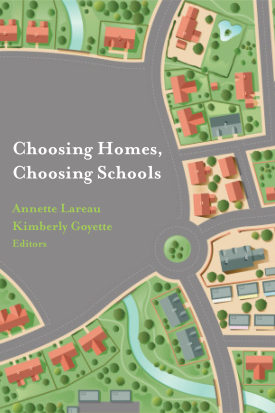
Choosing Homes, Choosing Schools
About This Book
“Where children live and attend school can exert powerful influences on their educational and social development. Understanding the forces at work in shaping patterns of residential and school segregation, therefore, is essential to understanding educational and social inequality in America. This thoughtful, theoretically rich, and empirically-grounded volume combines careful statistical analyses with rich, evocative parental interviews to provide a wealth of new evidence and insight into these complex forces. It is a ‘must-read’ for urban sociologists and education policy makers interested in understanding modern American inequality, segregation, and educational opportunity.”
—Sean Reardon, professor of sociology and director, Stanford Interdisciplinary Doctoral Training Program in Quantitative Education Policy Analysis
“Choosing Homes, Choosing Schools is an outstanding volume with contributions from prominent scholars that provides a detailed accounting of how residential and school sorting processes are intricately linked. The central theme is that residential segregation directly contributes to educational inequality, which in turn reinforces segregation when affluent (often white) families seek to avoid poor and minority schools. The book describes these processes in a changing social, demographic, economic, and policy context, and is informed by an excellent mix of theory, quantitative analysis, and qualitative work.”
—John Iceland, professor of sociology and demography, Penn State University
A series of policy shifts over the past decade promises to change how Americans decide where to send their children to school. In theory, the expanded use of standardized test scores and the boom in charter schools will allow parents to evaluate their assigned neighborhood school, or move in search of a better option. But what kind of data do parents actually use while choosing schools? Are there differences among suburban and urban families? How do parents’ choices influence school and residential segregation? Choosing Homes, Choosing Schools presents a breakthrough analysis of the new era of school choice, and what it portends for American neighborhoods.
The distinguished contributors to Choosing Homes, Choosing Schools investigate the complex relationships among education, neighborhood social networks, and larger patterns of inequality. Paul Jargowsky reviews recent trends in segregation by race and class, and shows that while segregation between blacks and whites has declined overall since 1970, white parents are still more likely to choose to live in predominantly white neighborhoods. This skewed residential selection in turn drives racial inequality in public schools. Annette Lareau draws on interviews with parents in three suburban neighborhoods to analyze school-choice decisions. Surprisingly, she finds that middle- and upper-class parents do not rely on active research, such as school tours or test scores. Instead, their decision-making was largely informal and passive, with most simply trusting advice from friends and others in their network. Elliot Weinginer looks at how class differences among urban parents affect their approaches to choosing schools. He finds that while parents of all backgrounds actively consider their children’s education choices, middle- and upper-class parents relied more on federally mandated school report cards, district websites, and online forums, while working-class parents used network contacts to gain information on school quality. Amy Schwartz and Leanna Stiefel explore the connections between housing policy and education reform. They demonstrate the shortcomings of policies focused exclusively on “school choice”—or the practice of allowing students to cross district boundaries to better schools—and instead advocate for reducing educational inequality by expanding residential choice through measures such as housing subsidies and the redevelopment of public housing to include schools and community centers.
Little previous research has explored what role school concerns play in the preferences of white and minority parents for particular neighborhoods, and how the racial and economic makeup of both neighborhoods and schools mutually reinforce each other. Choosing Homes, Choosing Schools adroitly addresses this gap and provides a firmer understanding of how Americans choose where to live and send their children to school.
ANNETTE LAREAU is Stanley I. Sheerr Term Professor in the Social Sciences and professor of sociology at the University of Pennsylvania.
KIMBERLY GOYETTE is associate professor of sociology at Temple University.
CONTRIBUTORS: Michael D. M. Bader, Felicia Butts, Kyle Crowder, Lori Delale-O’Connor, Stefanie DeLuca, Kimberly Goyette, Caroline Hanley, Paul A. Jargowsky, Shelley McDonough Kimelberg, Maria Krysan, Annette Lareau, Mary Pattillo, Anna Rhodes, Salvatore Saporito, Amy Ellen Schwartz, Leanna Stiefel, Elliot B. Weininger
